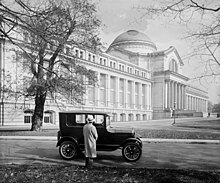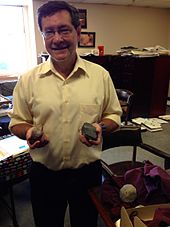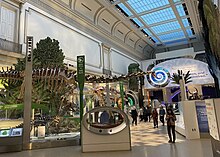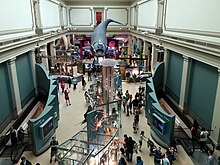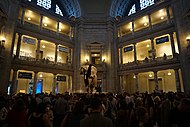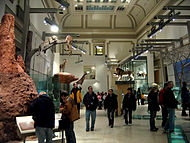
The Smithsonian Institution, or simply the Smithsonian, is a group of museums, education and research centers, the largest such complex in the world, created by the U.S. government "for the increase and diffusion of knowledge." Founded on August 10, 1846, it operates as a trust instrumentality and is not formally a part of any of the three branches of the federal government. The institution is named after its founding donor, British scientist James Smithson. It was originally organized as the United States National Museum, but that name ceased to exist administratively in 1967.

The Field Museum of Natural History (FMNH), also known as The Field Museum, is a natural history museum in Chicago, Illinois, and is one of the largest such museums in the world. The museum is popular for the size and quality of its educational and scientific programs, and its extensive scientific specimen and artifact collections. The permanent exhibitions, which attract up to 2 million visitors annually, include fossils, current cultures from around the world, and interactive programming demonstrating today's urgent conservation needs. The museum is named in honor of its first major benefactor, Marshall Field, the department-store magnate. The museum and its collections originated from the 1893 World's Columbian Exposition and the artifacts displayed at the fair.

The American Museum of Natural History (AMNH) is a natural history museum on the Upper West Side of Manhattan in New York City. Located in Theodore Roosevelt Park, across the street from Central Park, the museum complex comprises 20 interconnected buildings housing 45 permanent exhibition halls, in addition to a planetarium and a library. The museum collections contain about 35 million specimens of plants, animals, fungi, fossils, minerals, rocks, meteorites, human remains, and human cultural artifacts, as well as specialized collections for frozen tissue and genomic and astrophysical data, of which only a small fraction can be displayed at any given time. The museum occupies more than 2,500,000 sq ft (232,258 m2). AMNH has a full-time scientific staff of 225, sponsors over 120 special field expeditions each year, and averages about five million visits annually.

The National Portrait Gallery (NPG) is a historic art museum between 7th, 9th, F, and G Streets NW in Washington, D.C., in the United States. Founded in 1962 and opened to the public in 1968, it is part of the Smithsonian Institution. Its collections focus on images of famous Americans. Along with the Smithsonian American Art Museum, the museum is housed in the historic Old Patent Office Building.

The Anacostia Community Museum is a community museum in the Anacostia neighborhood of Washington, D.C., in the United States. It is one of twenty museums under the umbrella of the Smithsonian Institution and was the first federally funded community museum in the United States. The museum, founded in 1967, was created with the intention to bring aspects of the Smithsonian museums, located on the National Mall, to the Anacostia neighborhood, with the hope that community members from the neighborhood would visit the main Smithsonian museums. It became federally funded in 1970 and focuses on the community in and around Anacostia in its exhibitions. This museum also houses a library.

The Burke Museum of Natural History and Culture is a natural history museum on the campus of the University of Washington, in Seattle, Washington, United States. It is administered by the UW College of Arts and Sciences. Established in 1899 as the Washington State Museum, the museum traces its origins to a high school naturalist club formed in 1879. The museum is the oldest in Washington state and boasts a collection of more than 16 million artifacts, including the world's largest collection of spread bird wings. The Burke Museum is the official state museum of Washington.
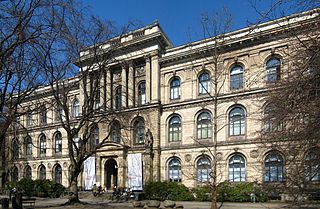
The Natural History Museum is a natural history museum located in Berlin, Germany. It exhibits a vast range of specimens from various segments of natural history and in such domain it is one of three major museums in Germany alongside Naturmuseum Senckenberg in Frankfurt and Museum Koenig in Bonn.

The Carnegie Museum of Natural History is a natural history museum in the Oakland neighborhood of Pittsburgh, Pennsylvania. It was founded by Pittsburgh-based industrialist Andrew Carnegie in 1896. Housing some 22 million specimens, the museum features one of the finest paleontological collections in the world.

The Denver Museum of Nature & Science is a municipal natural history and science museum in Denver, Colorado. It is a resource for informal science education in the Rocky Mountain region. A variety of exhibitions, programs, and activities help museum visitors learn about the natural history of Colorado, Earth, and the universe. The 716,000-square-foot (66,519 m2) building houses more than one million objects in its collections including natural history and anthropological materials, as well as archival and library resources.

Naturalis Biodiversity Center is a national museum of natural history and a research center on biodiversity in Leiden, Netherlands. It was named the European Museum of the Year 2021. Although its current name and organization are relatively recent, the history of Naturalis can be traced back to the early 1800s. Its collection includes approximately 42 million specimens, making it one of the largest natural history collections in the world.
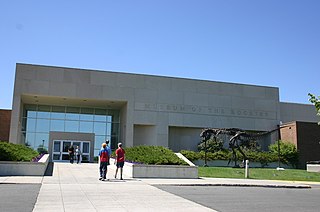
Museum of the Rockies is a museum in Bozeman, Montana. Originally affiliated with Montana State University in Bozeman, and now also, the Smithsonian Institution. The museum is largely known for its Paleontological collections as well as having the largest collection of North American Dinosaur fossils in the United States. They also possess the largest Tyrannosaurus skull ever discovered, as well as the thigh bone of a Tyrannosaurus Rex that contains soft-tissue remains. The museum is part of the Montana Dinosaur Trail and is Montana's official repository for Paleontological specimens.

The Houston Museum of Natural Science is a natural history museum located on the northern border of Hermann Park in Houston, Texas, United States. The museum was established in 1909 by the Houston Museum and Scientific Society, an organization whose goals were to provide a free institution for the people of Houston focusing on education and science. The museum complex consists of a central facility with four floors of natural science halls and exhibits, the Burke Baker Planetarium, the Cockrell Butterfly Center, and the Wortham Giant Screen Theatre. In 2022, the museum received 1,520,000 visitors, making it seventh on the List of most-visited museums in the United States, and was the third most-visited U.S. science museum. Much of the museum's popularity is attributed to its large number of special or guest exhibits.

Charles Whitney Gilmore was an American paleontologist who gained renown in the early 20th century for his work on vertebrate fossils during his career at the United States National Museum. Gilmore named many dinosaurs in North America and Mongolia, including the Cretaceous sauropod Alamosaurus, Alectrosaurus, Archaeornithomimus, Bactrosaurus, Brachyceratops, Chirostenotes, Mongolosaurus, Parrosaurus, Pinacosaurus, Styracosaurus ovatus and Thescelosaurus.

The Museum of the Earth is a natural history museum located in Ithaca, New York. The museum was opened in 2003 as part of the Paleontological Research Institution (PRI), an independent organization pursuing research and education in the history of the Earth and its life. Both PRI and the Museum of the Earth are formally affiliated with Cornell University. The Museum of the Earth is home to Earth science exhibits and science-related art displays with a focus on the concurrent evolution of the Earth and life.

"Stan", also known by its inventory number BHI 3033, is a Tyrannosaurus rex fossil found in the Hell Creek Formation in South Dakota, just outside of Buffalo in 1987, and excavated in 1992. It is the fifth most complete T. rex fossil discovered to date, at more than 70% bulk. In October 2020, the fossil was sold for $31.8 million at auction, making it the most expensive dinosaur specimen and fossil ever sold. In March 2022 Abu Dhabi's Department of Culture and Tourism stated that they had acquired Stan and were planning on displaying the fossil at a new museum of natural history scheduled to open in 2025.

Tyrannosaurus is one of the most iconic dinosaurs and is known from numerous specimens, some of which have individually acquired notability due to their scientific significance and media coverage.
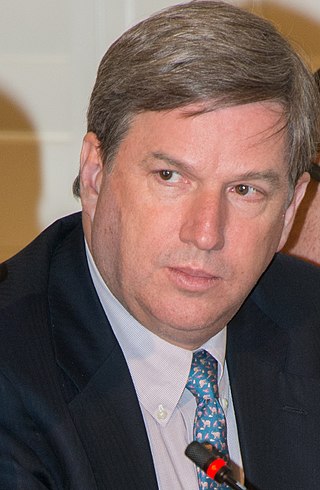
Cristián Samper is a Colombian-American tropical biologist specializing in conservation biology and environmental policy. He is the Managing Director and Leader of Nature Solutions at the Bezos Earth Fund. He served as President and CEO of WCS from 2012 to 2022. He was the Director of the Smithsonian Institution's National Museum of Natural History, the world's largest natural history collection, from 2003 to 2012, and served as acting Secretary of the Smithsonian from 2007 to 2008, the first Latin American to hold the position. In April 2015, Samper was inducted into the American Academy of Arts and Sciences.
The Smithsonian Ocean Portal is an educational website created and maintained by the Smithsonian Institution's National Museum of Natural History in Washington, DC. The website features regularly updated, original content from the museum's research, collections, and Sant Ocean Hall as well as content provided by a number of collaborating organizations. According to the site's statement of purpose, the Ocean Portal was created to "help increase public knowledge about the ocean and marine science, raise public awareness of the ocean's importance to all life, and inspire millions of online visitors to become caring ocean stewards." Supported by private donations, the Ocean Portal is designed to appeal to a broad audience, but the primary audiences are young adults, ocean enthusiasts, educators, and children ages 9–13.
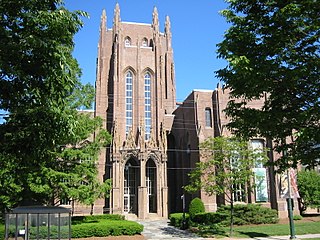
The Peabody Museum of Natural History at Yale University is one of the oldest, largest, and most prolific university natural history museums in the world. It was founded by the philanthropist George Peabody in 1866 at the behest of his nephew Othniel Charles Marsh, an early paleontologist. The museum is best known for the Great Hall of Dinosaurs, which includes a mounted juvenile Brontosaurus and the 110-foot-long (34 m) mural The Age of Reptiles. The museum also has permanent exhibits dedicated to human and mammal evolution; wildlife dioramas; Egyptian artifacts; local birds and minerals; and Native Americans of Connecticut.

Trix is a Tyrannosaurus rex specimen excavated in 2013 in Montana, United States by a team of paleontologists from the Naturalis Biodiversity Center in Leiden, the Netherlands and Black Hills institute of Geological Research in South Dakota. This Tyrannosaurus, over thirty years old – the oldest known Tyrannosaurus specimen – lived about 67 million years ago. It is considered to be the third most complete Tyrannosaurus found, with between 78% and 80% of its bone volume recovered. The specimen was named Trix after the former Queen Beatrix of the Netherlands. It is one of only two Tyrannosaurus specimens on permanent exhibit in mainland Europe. The other one is a specimen named Tristan on exhibit at the Natural History Museum of Berlin.


